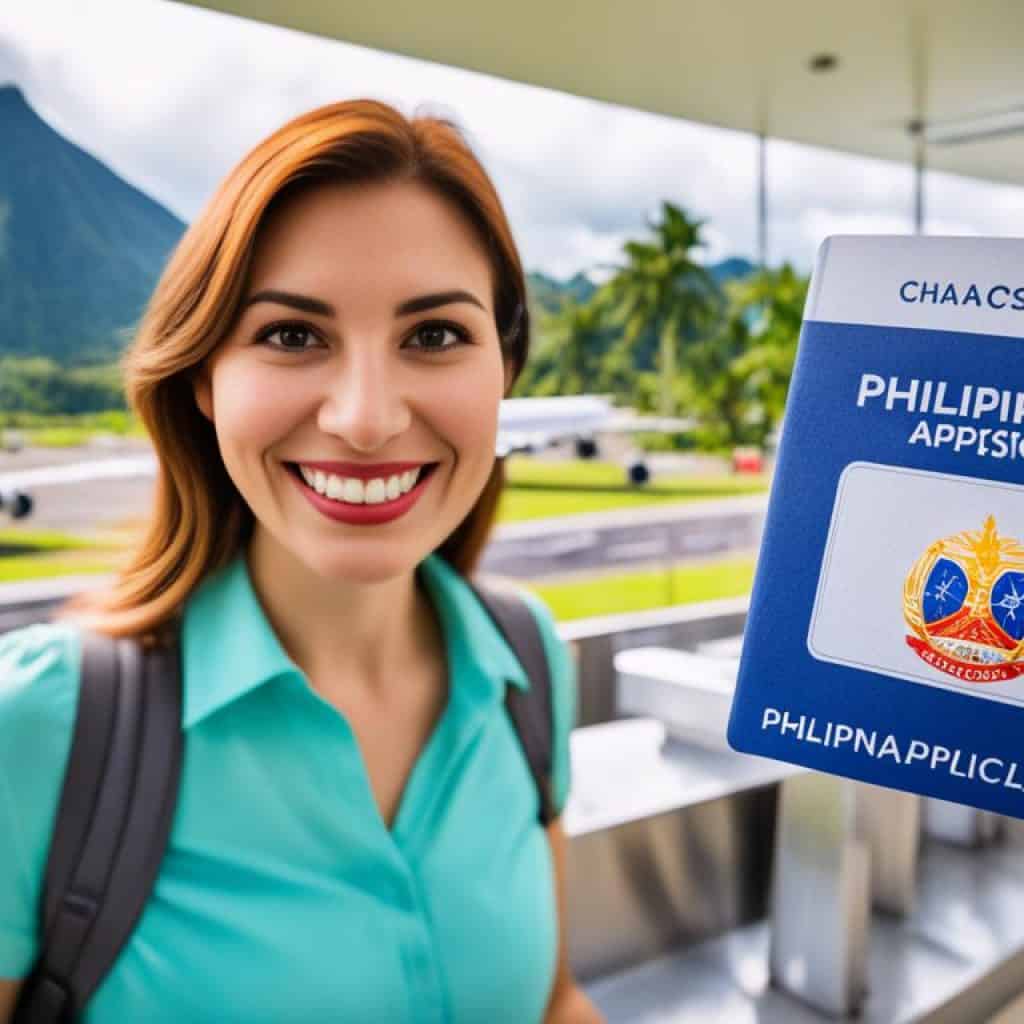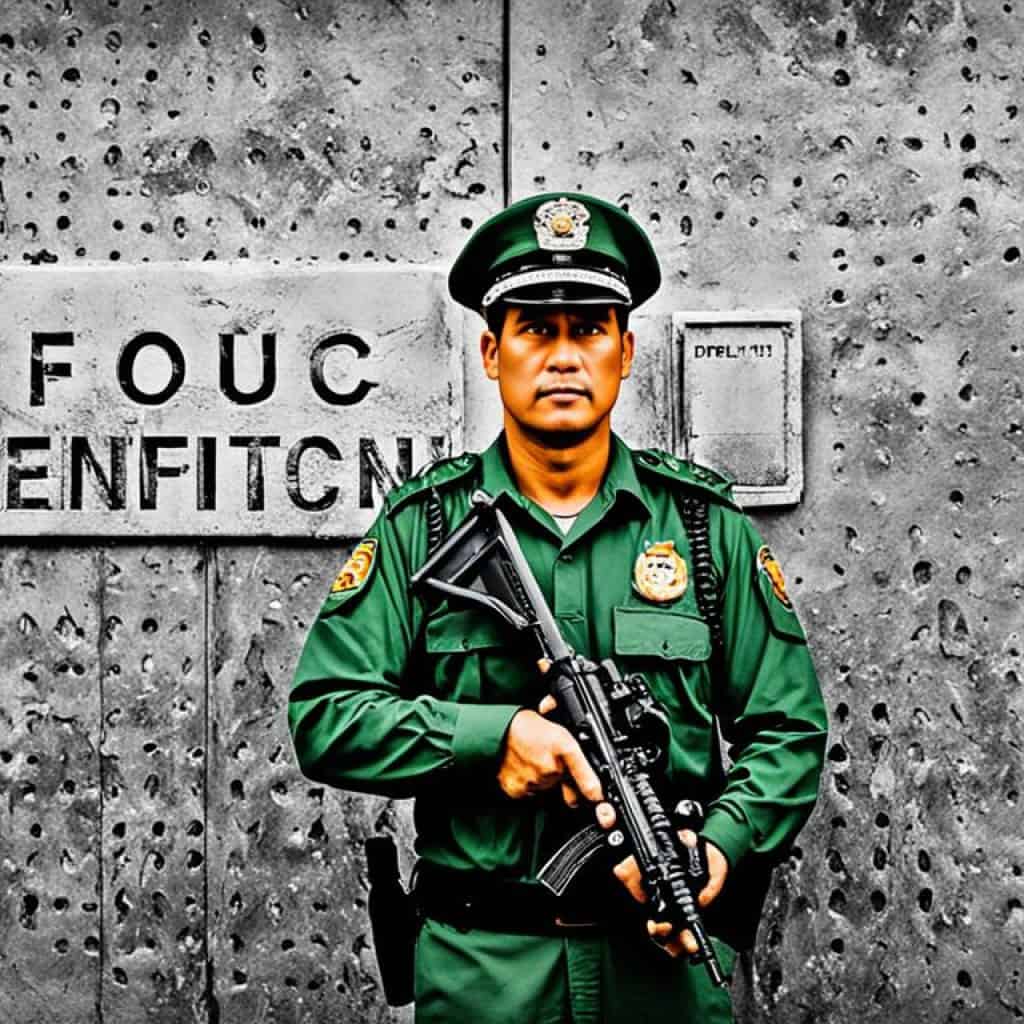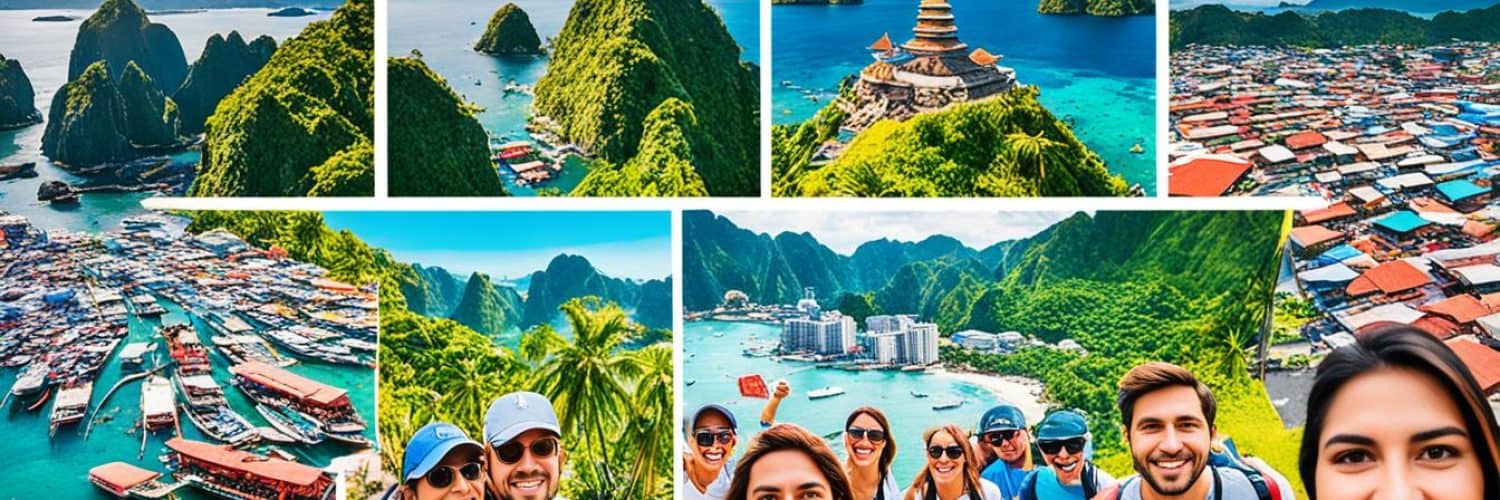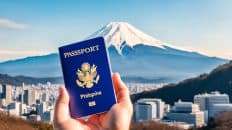Are you planning a trip to the beautiful Philippines? Before you start packing, know the visa rules. Some travelers can enter without a visa, while others might need one for longer visits. So, are you wondering if you need a visa?
We’ll go over the Philippines’ visa policies and the different visas you can get. We cover everything, from short trips to moving there permanently. You’ll also learn how to apply and what documents you need. Plus, we’ll share important safety tips for a great stay.
Key Takeaways:
- Citizens of certain countries can enter the Philippines visa-free for short stays up to 59 days.
- For stays longer than 59 days, a visa or visa extension is required.
- The Philippines offers three main types of visas: Non-Immigrant Visas, Immigrant Visas, and Special Visas.
- There are different application methods, including applying at an Embassy or Consulate, Visa On Arrival, and online application for citizens of Taiwan.
- Make sure to have the required documents, such as a completed visa application form, valid passport, proof of return or onward travel, and proof of financial means.
Do I Need a Visa for the Philippines?
Planning a trip to the Philippines? Understanding the visa rules is key. Many countries can enter without a visa for short stays. This includes ASEAN, EU, Canada, Australia, and US citizens. They can enjoy the Philippines visa-free up to 59 days, based on their nationality.
Want to stay longer than 59 days? You’ll need a visa or a visa extension. It’s smart to check visa needs for your country before your trip. This helps you get ready and follow the Philippine government’s rules.
In summary, citizens from certain countries can visit the Philippines without a visa for brief visits. But, if you’re staying longer or your country is not on the list, understand the visa requirements. This will make your travel smooth and enjoyable.
Types of Philippine Visas
The Philippine government offers various visas for people from abroad. These visas serve different reasons for staying. You can find Non-Immigrant Visas, Immigrant Visas, and Special Visas.
Non-Immigrant Visas: For short visits, Non-Immigrant Visas are perfect. They are ideal for tourists, business people, or students.
- Tourist Visas: Tourist Visas let you explore the Philippines for fun. They are great for seeing the beaches, landmarks, and culture.
- Business Visas: Business Visas are for foreign professionals in the country for work. They suit those attending meetings or exploring business opportunities.
- Student Visas: Student Visas are for those wanting to study in the Philippines. They allow international students to earn degrees or diplomas there.
Immigrant Visas: Immigrant Visas are for those wanting to live in the Philippines forever. They are for skilled foreigners, former citizens, and their families.
Special Visas: Special Visas are for specific situations. They help people with unique needs stay in the Philippines:
- Special Investors Resident Visa: This visa is for investors aiming to boost the Philippine economy with their investments.
- Special Visa for Employment Generation: This visa helps foreigners who create jobs by starting businesses in the Philippines.
- Special Resident Retiree Visa: Retirees looking to live their retirement in the Philippines can choose this visa. It offers great benefits and incentives.
Each visa type comes with its own rules and necessary paperwork. Knowing the differences helps you pick the right visa for your trip.
| Visa Type | Purpose of Stay | Eligibility |
|---|---|---|
| Tourist Visa | Recreational purposes | Open to all nationalities, subject to certain exceptions |
| Business Visa | Engaging in business-related activities | Open to all nationalities, subject to certain exceptions |
| Student Visa | Enrollment in higher education institutions | Open to all nationalities, subject to meeting institutional requirements |
| Immigrant Visa | Permanent residency in the Philippines | Varies based on specific eligibility criteria |
| Special Investors Resident Visa | Substantial investment in the Philippines | Subject to investment requirements set by the Philippine government |
| Special Visa for Employment Generation | Establishing a business or industry in the Philippines | Subject to meeting specific business and employment requirements |
| Special Resident Retiree Visa | Retirement in the Philippines | Subject to meeting retirement criteria set by the Philippine government |
Philippines Tourist Visa (Temporary Stay)
The Philippines Tourist Visa is for short-term visits. It’s for tourists, medical treatment, business, or visiting family. Some don’t need it, but others must apply at an Embassy or upon arrival.
Planning a trip to the Philippines? If you’re going to explore or visit people, you might need a tourist visa. This visa lets you stay temporarily without working.
To get a Philippines Tourist Visa, apply in advance or upon arrival. It depends on what you prefer for your travel.
Prefer to organize your trip early? Applying in advance is best. Visit the official website of the Philippine Embassy in your country for details. You’ll need to provide an application form, valid passport, travel plans, financial proof, and any other requested documents.
If you want flexibility or aren’t sure about your plans, consider a Visa On Arrival. This option lets you apply when you land in the Philippines. Check if your country qualifies for Visa On Arrival and know the requirements and fees. It’s not available for all nationalities, so it’s important to verify beforehand.
Applying for a Philippines Tourist Visa On Arrival
If you qualify for the Visa On Arrival, you’ll fill out paperwork at the airport. Forms are available there or online from the Philippines Immigration Bureau. Bring a valid passport, photos, travel and financial proofs, and any other needed documents.
Although convenient, it’s wise to prepare your documents before you arrive. This reduces delays and issues at the airport. Have everything ready for the immigration officers.
Whether applying in advance or on arrival, know the requirements and procedures. With the right visa, you’re all set to enjoy the Philippines’ beauty and adventures.
How Can I Apply for a Philippines Visa?
There are three easy ways to get a visa for the Philippines. You can apply at an Embassy or Consulate, get a Visa On Arrival, or apply online. Each method is designed to be simple and quick.
Embassy or Consulate Application
If you like to plan ahead, you can get your visa at an Embassy or Consulate. This is good for those who want their visa ready before their trip. But, the requirements might be different at each location, so it’s best to check in advance.
Visa On Arrival
Travelers from some countries, like the US and UK, can get their visa when they arrive in the Philippines. This option skips the pre-trip application. But, it’s not available to everyone. Be sure to check if your country is eligible.
Online Application for Citizens of Taiwan
If you’re from Taiwan, you can apply for your visa online. This is done through the Manila Economic and Cultural Office’s website. You just fill out forms, pay, and get your visa online. It’s a quick and easy way to get your visa.
Regardless of how you apply, make sure to follow all instructions and prepare your documents well. This helps avoid any last-minute issues.

| Application Method | Pros | Cons |
|---|---|---|
| Embassy or Consulate Application |
|
|
| Visa On Arrival |
|
|
| Online Application for Citizens of Taiwan |
|
|
When choosing how to apply, think about your trip dates, how convenient you want the process to be, and your country’s requirements. Knowing the options and following the steps carefully will make getting your visa easier.
Philippines Visa Requirements
When you apply for a visa to the Philippines, you must submit some documents. These include:
- A completed and signed Philippines Visa Application Form
- A valid passport with at least six months validity and two blank pages
- Passport-size photos
- Proof of return or onward travel
- Proof of sufficient financial means
- Proof of employment or enrollment
- Payment of the visa fee
There might be more documents needed for long-stay visas. Make sure to check the visa type you’re applying for.
Documents from other countries, like birth or marriage certificates, may need verification. This is done by the Philippine Embassy.
Applying for a visa to the Philippines requires attention to detail. Make sure you include every necessary document. This way, you’ll have a better chance of getting your visa.
“To get a visa for the Philippines, fill out the application and include all needed documents. Valid passport, photos, and proof of travel are crucial. Don’t miss any required information for a smooth process.” – Travel Expert
| Document | Requirement |
|---|---|
| Completed Visa Application Form | Must be filled out accurately and signed |
| Valid Passport | Must have at least six months validity and two blank pages |
| Passport-size Photos | Usually two photos are required |
| Proof of Return or Onward Travel | Valid flight or travel itinerary |
| Proof of Sufficient Financial Means | Bank statements or other financial documents |
| Proof of Employment or Enrollment | Letter from employer or enrollment certificate |
| Payment of Visa Fee | Varies depending on the type of visa |
Philippines Visa Requirements for Minors
Are you traveling to the Philippines with a minor? Knowing the visa requirements is key for a smooth trip. If minors are traveling alone, they need these documents:
- A birth certificate to confirm the minor’s age and identity.
- The valid passport of the parent(s) or guardian(s) to show parentage.
- The flight itinerary for details about the travel plans.
- A notarized authorization to travel from the parent(s) or guardian(s).
In some situations, bank statements from the parent(s) or guardian(s) may be needed. These show financial support for the minor’s trip. Keep in mind, more documents might be required based on travel reasons and personal circumstances.
| Document | Description |
|---|---|
| Birth Certificate | The minor’s birth certificate confirms their identity and age. |
| Valid Passport (Parent/Guardian) | A copy of the parent(s) or guardian’s passport shows parentage. |
| Flight Itinerary | Details of the minor’s travel plans are in the flight itinerary. |
| Notarized Authorization to Travel | Parents or guardians must provide a notarized travel authorization. |
| Bank Statements | Bank statements may be needed for financial support proof. |
Having all needed documents ready will make your child’s travel smoother. It’s wise to check with the Philippine Embassy or Consulate for any new or extra requirements. This is especially important if your situation is unique.
Applying for a Philippines Visa On Arrival
Most travelers can apply for a Philippines Visa On Arrival. But, some countries aren’t eligible due to the rules of the Philippines Immigration Bureau. You can get the visa application form on the official Philippines Immigration Bureau website.
At the Philippines immigration checkpoint, show your filled visa form and needed documents. The immigration officers will check your application. They will then give you the visa to enter the country.
Documents required for Philippines Visa On Arrival:
- A valid passport with at least six months validity and two blank pages
- Completed Philippines Visa On Arrival application form
- Proof of return or onward travel
- Proof of sufficient financial means
- Proof of accommodation in the Philippines
- Travel itinerary
Not all countries can get a Philippines Visa On Arrival. Check if your country is eligible and meet all the requirements before your trip.
Applying for a Philippines Visa Online (eTA)
Taiwan citizens can apply for a Philippines visa online. This is done via the Manila Economic and Cultural Office website. Known as the Electronic Travel Authorization (eTA), it offers a straightforward way to get entry permission completely online.
Completing the eTA form is simple on the Manila office’s official site. You’ll need to input current personal info, passport details, travel plans, and visit purpose. Make sure all the information is accurate and matches your passport.
After filling out the form, you can pay the visa fee online. The payment system is secure, allowing for a worry-free transaction. Once you pay, the authorities will begin processing your application.
When your eTA application is approved, you’ll get an email with the visa. It’s wise to print this eTA to show the immigration officers when you arrive in the Philippines. This eTA confirms your travel clearance and states how long you can stay.
The eTA makes applying for a Philippines visa easy for Taiwan citizens. It skips the trip to an Embassy or Consulate. This process makes getting the needed travel paperwork faster. By using the eTA, travelers will have a smoother time entering the Philippines. They can then enjoy their time in this beautiful country.
Applying online for a Philippines visa is handy for Taiwan citizens. The eTA process streamlines the application steps. Travelers fill out a form, pay, and get their visa by email. This effective system ensures easy Philippines entry, making travel pleasant.
Processing Time for Philippines Visa Applications
Planning your trip to the Philippines requires considering the visa processing time. This time can change based on the Embassy or Consulate and how complete your application is.
Usually, it takes from two to ten working days to process a Philippines visa application. To avoid any rush, apply well before your travel date. This is crucial during busy travel times with many applications.
Having all needed documents ready can speed up the process. You’ll need a signed visa application form, a valid passport, photos, travel proof, funds proof, and documents for your visa type.
Submitting a full and correct application increases the chance of a quick process. Remember, processing times can change, so always check with the Embassy or Consulate.
Applying in person vs. online
You might be able to apply for a visa in person or online, depending on where you live. These methods can have different processing times.
Applying in person means scheduling a visit, which might take longer. But, online applications can be quicker since they’re electronic.
It’s best to know the requirements and times for each method before deciding.
Plan ahead for a smooth travel experience
Planning ahead makes for a better trip to the Philippines. Apply for your visa early to avoid any last-minute issues.
Track your visa status and contact the Embassy or Consulate if needed. Being prepared helps you dodge delays, letting you enjoy your Philippines visit.
| Visa Type | Processing Time |
|---|---|
| Tourist Visa | 2-10 working days |
| Business Visa | 2-10 working days |
| Student Visa | 2-10 working days |
| Special Visa | 2-10 working days |
| Transit Visa | 2-10 working days |
Processing times can vary based on many factors and the Embassy or Consulate. Always check for the latest information.
Safety and Security Information
This article mainly talks about visa needs. But, it’s also key to think about safety and security in the Philippines. The US Department of State warns travelers because of terrorism, crime, and kidnapping risks in some areas.
To keep safe during your trip, you should:
- Stay alert and vigilant at all times.
- Avoid high-profile public events and crowded places.
- Be wary of strangers and always know what’s happening around you.
- Be careful when using public transport or taxis.
The Philippine government is working hard to make things safer. They are focusing on tourist spots and big cities. Even so, it’s best to keep up with travel alerts and talk to local officials about safety.
“Your safety matters most when visiting the Philippines. Stay alert and obey local laws to enjoy your trip without worries.”
If you stay informed and careful, your time in the Philippines can be both safe and fun.

Emergency Contacts
In emergencies, having the right contact numbers is crucial:
| Emergency Service | Contact Number |
|---|---|
| Police | 911 |
| Fire Department | 911 |
| Ambulance | 911 |
| Local Tourist Police | 911 |
| Embassy/Consulate | Check with your country’s embassy/consulate in the Philippines |
Tourism in the Philippines
The Philippines is a tropical paradise with lots to see. It’s perfect for those wanting beautiful landscapes, beaches, and culture. No matter what you’re after, adventure, relaxation, or history, you’ll find it here.
The Philippines’ beaches are world-class. Boracay has white sands and clear waters. Palawan is also a must-see, with stunning islands and marine life. These spots are great for snorkeling, diving, or sunbathing.
If you love history, Manila and Cebu are for you. Manila blends old Spanish architecture with modern buildings. Intramuros, its walled city, shows the colonial past. Cebu is famous for landmarks like Fort San Pedro and Magellan’s Cross, showing Spanish influence.
The Philippines has amazing natural wonders too. The Banaue Rice Terraces, over 2,000 years old, are a UNESCO site. They show the skill and land connection of Filipino farmers. Bohol’s Chocolate Hills are also unique, turning brown in the dry season.
The Philippines is full of diverse and charming tourist spots. You’ll find beautiful beaches, historic sites, and natural wonders.
Plan your trip to the Philippines carefully. Check travel advisories and guidelines from the Philippine Department of Tourism. Being informed will help make your trip smooth and fun.
Philippines Tourist Destinations
| Tourist Destination | Description |
|---|---|
| Boracay | A world-renowned beach destination known for its powdery white sand and vibrant nightlife. |
| Palawan | Home to the stunning Bacuit Archipelago and the UNESCO-listed Puerto Princesa Underground River. |
| Manila | The bustling capital city that offers a vibrant mix of history, culture, and modernity. |
| Cebu | A thriving city with a rich historical and cultural heritage, famous for its Sinulog Festival. |
| Banaue Rice Terraces | A mesmerizing terraced landscape carved by Ifugao tribespeople, showcasing their agricultural ingenuity. |
| Bohol | Known for its unique Chocolate Hills and captivating marine biodiversity. |
These are just a few examples of what you can discover in the Philippines. Start your adventure and experience the beauty and culture of this tropical paradise.
Conclusion
Knowing about the Philippines visa needs is key for a worry-free trip to this lovely country. Whether going for fun, work, or other reasons, checking visa needs for your country is a must. By doing what’s needed and supplying the right papers, you make your visa process smooth.
While in the Philippines, keeping safe should be a top priority. The country has beautiful beaches, nature, and culture. But, it’s wise to be aware of travel advisories from the Philippine Department of Tourism. Being careful and aware lets you enjoy your time and discover the Philippines’ beauty.
Plan your journey early, get your documents ready, and talk to the Philippine Embassy or Consulate for the latest visa info. Remember, visa processing times can differ, so apply early before your trip. With good planning and a focus on safety, your Philippine visit will be unforgettable.


















Add comment